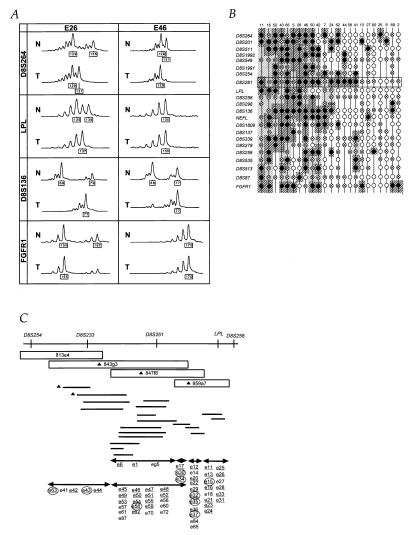Figure 1.
LOH at human chromosome 8p in primary esophageal cancer samples and genomic contigs at 8p22. (A) Representative LOH analysis from two cases, E26 and E46. Fluorescent PCR products from normal (N) and tumor (T) DNAs were analyzed. The x axis shows DNA fragment size in bp (depicted in boxes, compared with size markers). Patient E26 was informative for all four markers; LOH for D8S264, LPL, and D8S136 and allelic retention in FGFR1 (because a 167-bp peak in tumor is more than 50% of that in normal). Patient E46 was informative at D8S264 and D8S136, and one allele at each was lost, whereas LPL and FGFR1 loci were homozygous. (B) Summary of LOH analyses. All the patients with loss at least at one locus are shown. The closed circles indicate loss of an allele, the circles with crosses indicate noninformation because of homozygosity, and the open circles depict the retention of both alleles. The dark hatched areas indicate regions of allele loss, whereas the light hatched areas show regions of noninformation within allele loss areas. Further studies focused on the region near the marker D8S261 locus shown in a boxed area. The column numbers correspond to patients, whereas the row numbers indicate polymorphic markers. (C) Genomic contigs at 8p22. The upper line depicts the location of polymorphic loci on 8p. YAC (boxes) and BAC (horizontal lines) contigs were constructed. The cDNA selection was performed on three YAC DNAs (triangles). The shotgun sequencing were carried out on BACs (triangles). Eighty-seven potentially expressed sequences were isolated and located within the contigs, which are shown in the lower portion. The underlined characters are the sequences that are expressed in normal tissues. A candidate fragment, e37, corresponds to the F37 cDNA described in text. Areas with arrows show locations of candidate cDNAs. After expression analysis in tumor and normal tissues, nine cDNAs (circled characters) were subjected to partial cloning and further analysis.

